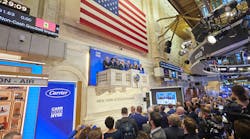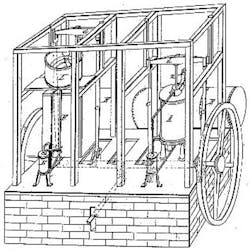Although Willis Carrier generally is credited with inventing air conditioning, in Florida, we recognize Dr. John Gorrie as both the father of air conditioning and the inventor of the ice-making machine. Apalachicola—an early Florida seaport and now an “Old Florida” tourist destination known for oysters and shrimp—has a monument to him, a replica of his ice machine on display in the John Gorrie Museum, and a bridge named after him. Dr. Gorrie made feverish sailors more comfortable by suspending basins of natural ice above their heads. When he would run out of ice, which he purchased from ships coming from the north, he would use a steam-driven air compressor to blow cold air over his patients. On a warm, humid evening sometime during the 1830s, the compressor ran longer than usual, and condensation on the supply pipe froze, clogging the pipe with ice. The good doctor spent years trying to perfect his accidentally discovered mechanical ice maker and was granted the first U.S. patent for mechanical refrigeration in 1851, 55 years before Carrier’s first patent. Dr. Gorrie's process used the rapid expansion of gases for cooling, the same principle most often used in refrigeration today.
As a South Floridian, I have a hard time imagining life without air conditioning. In 2013, Raymond Ostby Arsenault, a history professor at the University of South Florida in St. Petersburg, wrote: "Florida as we know it would not exist without air conditioning. We'd probably still be a state of 4 or 5 million instead of 19 million."
In many countries with climates even warmer and more humid than South Florida’s, air conditioning is a rarity, often reserved for the wealthy. That may be changing, however. According to a recent study by Lawrence Berkeley National Laboratory, air-conditioning sales in many emerging high-population economies are growing at a rate of 10 percent to 15 percent a year. In another study, researchers from the University of California, Berkeley and the National Bureau of Economic Research found that if incomes in Mexico increase 2 percent a year, 71 percent to 81 percent of Mexican households will have air conditioning by the end of the century, compared with just 13 percent today. (In comparison, 90 percent of Americans have air conditioning in their homes.) If these studies are correct, the world’s installed air-conditioning inventory is going to increase by 700 million units.
That’s good for our industry, but could be disastrous for the environment. We need to continue to phase out hydrofluorocarbons and increase research and development of more efficient equipment. We also, according to U.S. Energy Secretary Ernest Moniz, need to encourage businesses that buy large volumes of air-conditioning equipment (e.g., hotels) to commit to using only high-efficiency models.










